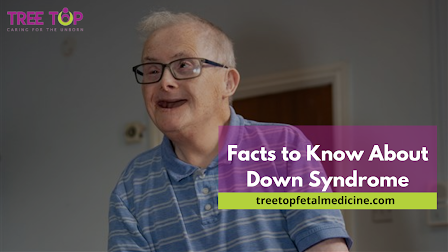Facts to Know About Down Syndrome
We all have heard the word down syndrome, which is generally found in babies. But what down syndrome is and how it affects health or how to cure it is still vague for many people. This article will give you all the facts one needs to know about down syndrome.
An extra chromosome causes the disorder known as Down syndrome. In the body, chromosomes are discrete "packages" of genes. They control how a baby's body develops during pregnancy and after birth, determining how it will look and work. A newborn typically has 46 chromosomes.
One of these chromosomes, chromosome 21, has an extra copy in infants with Down syndrome. Trisomy is the medical word for having an extra copy of a chromosome. Trisomy 21 is another term used to describe Down syndrome. The newborn may experience difficulties with their mental and physical development due to this additional copy, which alters how their body and brain grow.
There are some defined physical features of down syndrome.
- Slouched appearance, particularly on the bridge of the nose.
- Almond-shaped, upward-slanted eyes.
- A narrow neck.
- Little ears.
- A tongue that frequently protrudes from the mouth.
- There are six tiny white specks on the iris (colored region of the eye).
- Seven little hands and feet.
- A single line runs across the hand's palm.
- Tiny pinky fingers, which occasionally bend toward the thumb.
- Weakened muscles or loose joints.
- Children and adults are both shorter in height.
Different Types of Down Syndrome
There are three types of down syndromes, and it is hard to tell the difference between them. Each kind's physical characteristics and behaviors are frequently similar, making it difficult for people to distinguish between them without looking at the chromosomes.
1 Mosaic Down Syndrome: About 2% of individuals with Down syndrome have Down mosaic syndrome. 2 Mosaic is a term for mixture or combination. Some of the cells in children with mosaic Down syndrome have three copies of chromosome 21, while others have the standard two copies. The characteristics of other Down syndrome children may also apply to children with mosaic Down syndrome.
2 Translocation Down syndrome: Translocation This kind of Down syndrome only makes up about 3% of all cases of the condition. 2 This happens when an extra chromosome 21 is present, but it is not a separate chromosome 21; instead, it is attached or "trans-located" to another chromosome.
3 Trisomy 21: About 95% of people living with Down syndrome also have Trisomy 21.2. Instead of the typical two copies of chromosome 21, each cell in the body in a person with this kind of Down syndrome has three copies.
Down Syndrome Diagnosis
Screening and diagnostic tests are the two main categories of testing available to identify Down syndrome during pregnancy. A screening test can inform the expectant mother and her healthcare practitioner of the likelihood of Down syndrome in the baby.
An ultrasound, which produces an image of the baby, is sometimes combined with a blood test, which counts the number of chemicals in the mother's blood. The fluid behind the baby's neck is one of the things the technician examines during an ultrasound.
Treatment For Down Syndrome
Down syndrome is a chronic illness. Early intervention services can frequently assist babies, and young children with Down syndrome develop their physical and intellectual capacities. These treatments, which generally come under early intervention programs in every state, include speech, occupational, and physical therapy. Most of these programs promote the full development of kids with Down syndrome. Even though many of them are integrated into ordinary courses, children with Down syndrome may require additional support or attention in the classroom.




Comments
Post a Comment